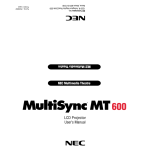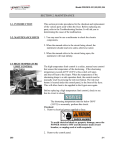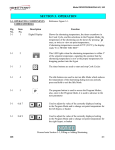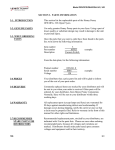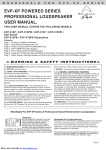Download Henny Penny 342 User's Manual
Transcript
Model OFE/OFG/OEA/OGA-341, 342 SECTION 2. MAINTENANCE 2-1. INTRODUCTION This section provides procedures for the check out and replacement of the various parts used within the fryer. Before replacing any parts refer to the Troubleshooting Section. It will aid you in determining the cause of the malfunction. 2-2. MAINTENANCE HINTS 1. You may need to use a multimeter to check the electric components. 2. When the manual refers to the circuit being closed, the multimeter should read zero unless otherwise noted. 3. When the manual refers to the circuit being open, the multimeter will read infinity. 2-3. HIGH TEMPERATURE LIMIT CONTROL (Gas Units) This high temperature control is a safety, manual reset control, which senses the temperature of the shortening. If the shortening temperature exceeds 425°F (218°C), this switch opens and shuts off heat to the frypot. When the temperature of the shortening drops to a safe operation limit, the control must be manually reset by pressing the red reset button. The red reset button is located under the control panel, in the front of the fryer. (Figure 2-1). This allows heat to be supplied to the frypot. Before replacing a high temperature limit control, check to see that its circuit is closed. Figure 2-1 The shortening temperature must be below 380°F (193°C) to accurately perform this check. Checkout To avoid electrical shock or property damage, move the power switch to OFF and disconnect main circuit breaker, or unplug cord at wall receptacle. 1. Remove the control panel. Figure 2-2. Figure 2-2 1003 2-1 Model OFE/OFG/OEA/OGA-341, 342 1-3. HIGH TEMPERATURE LIMIT CONTROL (Gas Units) (Continued) 2. Using a Phillip’s head screwdriver, remove the screws securing the inner heat shield and remove from unit. Figure 2-3. Figure 2-3 3. Remove the screw securing the high limit bracket to the frame and remove the high limit and bracket from unit. Figure 2-4. Figure 2-4 4. Remove the two screws securing the high limit to the bracket and remove the high limit from bracket. 5. Remove the two electrical wires from the high temperature limit control. Figure 2-5. Figure 2-5 6. Manually reset the control, then check for continuity between the two terminals after resetting the control. If the circuit is open, replace the control, then continue with this procedure. (If the circuit is closed, the high limit is not defective. Reconnect the two electrical wires.) 2-2 1003 Model OFE/OFG/OEA/OGA-341, 342 2-3. HIGH TEMPERATURE LIMIT CONTROL (Gas Units) (Continued) Replacement To avoid electrical shock or property damage, move the power switch to OFF and disconnect main circuit breaker, or unplug cord at wall receptacle. 1. If the tube is broken or cracked, the control opens, shutting off electrical power to the heat circuit. The control cannot be reset, and it continuously clicks when pushed. 2. Drain the shortening from the frypot and discard. A substance from the tube could contaminate the shortening. Figure 2-6 3. Remove the control panel. 4. Using a 5/16” wrench, loosen small inside screw nut on capillary tube. Figure 2-6. 5. Using a 11/16” crows-foot, remove the larger nut securing the capillary tube to the pot. Figure 2-7. Figure 2-7 6. Remove the two screws securing the high limit guard and remove guard. Figure 2-8 7. Straighten the capillary tube inside the frypot, and pull the capillary tube through the frypot, from behind the control panel. Remove the defective high limit from the control panel area. 8. Replace new high limit in reverse order. Figure 2-8 To avoid electrical shock or other injury, run the capillary line under and away from all electrical power wires and terminals. The tube must never be in such a position where it could accidentally touch the electrical power terminals. 1003 2-3 Model OFE/OFG/OEA/OGA-341, 342 2-4. COMPLETE CONTROL PANEL REPLACEMENT Should the control board become inoperative, follow these instructions for replacing the board. 1. Remove electrical power supplied to the unit. To avoid electrical shock or property damage, move the power switch to OFF and disconnect main circuit breaker, or unplug cord at wall receptacle. Figure 2-9 2. Remove the two screws securing the control panel and lift out. Figure 2-9. 3. Unplug the wire connectors going to the control panel. Figure 2-10. 4. Remove transformer(s) from control panel. They must be installed on the replacement panels. 5. Install new control panel in reverse order. Figure 2-10 2-5. POWER SWITCH When plugging connectors onto new control panel, be sure the connectors are inserted onto all of the pins, and that the connectors are not forced onto the pins backwards. If not connected properly, damage to the board could result. 1. Remove electrical power supplied to fryer. To avoid electrical shock or property damage, move the power switch to OFF and disconnect main circuit breaker, or unplug cord at wall receptacle. 2. Remove control panel. Figure 2-11 2-4 3. Label and remove wires from the switch. With test instrument check across the terminals of the switch with switch in the on position, and the circuit should be closed. In the off position, the circuit should be open. If the switch checks defective, replace by continuing with this procedure. Figure 2-11. 504 Model OFE/OFG/OEA/OGA-341, 342 2-5. POWER SWITCH (Continued) 4. With control panel removed, and the wires off the switch, push in on tabs on the switch to remove from panel. Figure 2-12. 5. Replace with new switch, and reconnect wires to switch. 6. Replace the control panel. Figure 2-12 2-6. TEMPERATURE PROBE REPLACEMENT (Gas) The temperature probe relays the actual shortening temperature to the control board. If it becomes disabled, “E06” shows in the display. Also, if the shortening temperature is out of calibration more than 10°F or C°, the probe should be replaced. An Ohm check can be performed also. See chart below. 1. Remove electrical power supplied to the fryer. Figure 2-13 To avoid electrical shock or property damage, move the power switch to OFF and disconnect main circuit breaker, or unplug cord at wall receptacle. 2. Drain the shortening from the frypot. 3. Remove the control panel and heat shield from control area. Figure 2-13. Figure 2-14 806 4. Using a ½ inch wrench, remove the nut on the compression fitting. Figure 2-14. 2-5 Model OFE/OFG/OEA/OGA-341, 342 2-6. TEMPERATURE PROBE 5. Remove the probe from the frypot, and disconnect wire REPLACEMENT (GAS) connector from the control panel. Figure 2-15. (Continued) 6. Place the nut and new ferrule on the new probe and insert the probe into the compression fitting until it extends one (1) inch (2.54cm) into the frypot. Figure 2-16. 7. Tighten hand tight and then a half turn with wrench. Figure 2-15 Excess force will damage probe. 8. Connect new probe to PC board and replace control panel. 9. Replace shortening, and turn power on to check out fryer. Figure 2-16 2-7. TEMPERATURE PROBE REPLACEMENT (Gas) REPLACEMENT (ELECTRIC) The temperature probe relays the actual shortening temperature to the control board. If it becomes disabled, “E06” shows in the display. Also, if the shortening temperature is out of calibration more than 10°F or C°, the probe should be replaced. An Ohm check can also be performed. See chart on page 2-5. 1. Remove electrical power supplied to the fryer. To avoid electrical shock or property damage, move the power switch to OFF and disconnect main circuit breaker, or unplug cord at wall receptacle. 2. Drain the shortening from the frypot. Figure 2-17 2-6 3. Remove screws securing rear cover of fryer, and remove rear cover. Figure 2-17. 1209 Model OFE/OFG/OEA/OGA-341, 342 2-7. TEMPERATURE PROBE 4. Using a ½ inch wrench, remove the nut on the compression REPLACEMENT fitting. Figure 2-18. (ELECTRIC) (Continued) 5. Remove the probe from the frypot, and disconnect probe. 6. Place the nut and new ferrule on the new probe and insert the probe into the compression fitting until it extends one (1) inch (2.54cm) into the frypot. Figure 2-18 2-8. FLAME SENSOR/ PILOT / IGNITOR ASSEMBLY (GAS) 7. Reconnect new probe onto wires, replace rear cover, and fryer is now ready for use. The Henny Penny open fryer (gas) has electronic spark ignition that lights a standing pilot. The gap between the spark electrode and the pilot hood should be1/8 of an inch (3.18 mm). The flame sensor recognizes the pilot flame and allows gas to continue to the pilot. The flame sensor must send a minimum of two (2) micro amps to the ignition module. The pilot flame should be split in two by the flame sensor, causing the flame sensor to be bright red in color. 1. Remove electrical power supplied to the unit. To avoid electrical shock or property damage, move the power switch to OFF and disconnect main circuit breaker, or unplug cord at wall receptacle. TO AVOID PERSONAL INJURY OR PROPERTY DAMAGE, BEFORE STARTING THIS PROCEDURE, MOVE THE MAIN POWER SWITCH TO THE OFF POSITION. DISCONNECT THE MAIN CIRCUIT BREAKERS AT THE CIRCUIT BREAKER BOX OR UNPLUG SERVICE CORD FROM WALL RECEPTACLE. TURN OFF THE MAIN GAS SUPPLY TO THE FRYER AND DISCONNECT AND CAP THE MAIN SUPPLY LINE TO FRYER, OR POSSIBLE EXPLOSION COULD RESULT. 1003 2-7 Model OFE/OFG/OEA/OGA-341, 342 2-8. FLAME SENSOR/ PILOT / IGNITOR ASSEMBLY (Gas) (Continued) 2. Remove the control panel and heat shield from control area. Figure 2-19. Figure 2-19 3. Disconnect the flame sense wire from ignition module. Figure 2-20. Figure 2-20 4. Using a 7/16” wrench, loosen the nut on the pilot tube and pull tube from assembly. Figure 2-21. Figure 2-21 5. Remove the two screws securing the assembly and pull assembly from unit. Figure 2-22. 6. Now the flame sensor or or pilot assembly can be removed from bracket. Figure 2-22 2-8 1003 Model OFE/OFG/OEA/OGA-341, 342 2-9. IGNITION MODULE During normal operation, the ignition modules send 24 volts to the ignitors and gas valve. If a module does not sense a pilot flame, the module starts the ignition process again. But, if a pilot light goes out for longer that 10 seconds, or it goes out 3 times within 10 seconds, the module keeps the 24 volts from reaching the gas valve. The burners shut down. 1. Remove electrical power supplied to the unit. To avoid electrical shock or property damage, move the power switch to OFF and disconnect main circuit breaker, or unplug cord at wall receptacle. Figure 2-23 2. Remove the control panel and heat shield from control area. Figure 2-23. 3. Using a 3/8 inch socket, remove the two nuts securing the module. Figure 2-24. Figure 2-24 4. Label and remove the wires at module. Figure 2-25. 5. Install new module in reverse order. Figure 2-25 1003 2-9 Model OFE/OFG/OEA/OGA-341, 342 2-10. TRANSFORMER REPLACEMENT The transformer reduces voltage down (to 24V) to accommodate those components with low voltage. 1. Remove electrical power supplied to the unit. To avoid electrical shock or property damage, move the power switch to OFF and disconnect main circuit breaker, or unplug cord at wall receptacle. 2. Remove the control panel Figure 2-26 3. Remove the two wire connectors to disconnect transformer From panel. Figure 2-26. 4. Using a 3/8” nut-driver, remove the two nuts securing the transformer to the panel and remove transformer. Figure 2-27. 5. Install the new transformer in reverse order. Figure 2-27 2-11. CONTROL & I/O BOARDS REPLACEMENT I/O Power Supply 1. Remove electrical power supplied to the unit. Control To avoid electrical shock or property damage, move the power switch to OFF and disconnect main circuit breaker, or unplug cord at wall receptacle. 2. Remove the control. 3. Using a 5/16” nut-driver or wrench, remove the 4 nuts securing the PC shield and remove shield. Figure 2-28. 4. Disconnect the wire assemblies from the appropriate board. Figure 2-28 5. Using a 5/16” nut-driver or wrench, remove the 4 nuts securing the appropriate board to the shroud. 6. Install the new board in reverse order. 2-10 1003 Model OFE/OFG/OEA/OGA-341, 342 2-12. VACUUM SWITCHThis switch senses the airflow from the induction blower. If REPLACEMENT the airflow is reduced below a set amount, the switch opens and the I/O board cuts power to the gas control valve, which shuts the pilot flame off. 1. Remove electrical power supplied to the unit. Figure 2-29 To avoid electrical shock or property damage, move the power switch to OFF and disconnect main circuit breaker, or unplug cord at wall receptacle. 2. Remove the control panel. 3. Remove the 2 screws securing the switch to the heat shield. Figure 2-29. 4. Remove the air hose from the air switch. Figure 2-30. Figure 2-30 5. Label and remove wires from air switch. Figure 2-31. 6. Install new vacuum switch in reverse order. Figure 2-31 1003 To avoid property damage, do not tamper with, or disas semble this component. It is set and sealed from the factory and is not to be adjusted. 2-11 Model OFE/OFG/OEA/OGA-341, 342 2-13. DRAIN MICROSWITCH Upon turning the drain handle, the drain microswitch should REPLACEMENT “open”, cutting off the pilot flame. This will prevent the fryer from heating while shortening is being drained from the frypot. 1. Remove electrical power supplied to the unit. To avoid electrical shock or property damage, move the power switch to OFF and disconnect main circuit breaker, or unplug cord at wall receptacle. 2. The following check should be made to determine if the drain microswitch is defective. Figure 2-32 a. Remove the two screws and nuts securing the microswitch to the drain rod valve bracket, and remove microswitch. Figure 2-32. b. Remove wires from the switch. Figure 2-33. c. Check for continuity across the two outside terminals of the drain switch. If the circuit is open, the drain switch is defective. The circuit opens by pressing on the actuator of the microswitch. 3. If defective, replace switch in reverse order. Figure 2-33 2-14. FILTER SWITCH REPLACEMENT 1. Remove electrical power supplied to the unit. To avoid electrical shock or property damage, move the power switch to OFF and disconnect main circuit breaker, or unplug cord at wall receptacle. Figure 2-34 2-12 2. Open the door (left door on 2 well units), and remove the 2 screws securing the switch box cover. Figure 2-34. 1003 Model OFE/OFG/OEA/OGA-341, 342 2-14. FILTER SWITCH REPLACEMENT (Continued) 3. Label and remove the wires from the switch. With test instrument check across the terminals of the switch. With the switch in the on position, the circuit should be closed. With the switch in the off position, the circuit should be open. If the switch is defective, replace by continuing with this procedure. Figure 2-35. Figure 2-35 4. With wires removed from the switch, push in on tabs on the switch and remove switch from front of switch box cover. Figure 2-36. 5. Push new switch into panel and reconnect wires. Figure 2-36 2-15. GAS CONTROL VALVE The gas valve assembly controls the flow of gas to the pilot and the REPLACEMENT main burner. The valve has two 24-volt coils, which are regulated by the P and M terminals on the valve. The C terminal is the common terminal. For gas flow to the pilot, 24 VAC must be present between the P and C terminals. For gas flow to the main burner, 24 VAC must be present between the M and C terminals. TO AVOID PERSONAL INJURY OR PROPERTY DAMAGE, BEFORE STARTING THIS PROCEDURE, MOVE THE MAIN POWER SWITCH TO THE OFF POSITION. DISCONNECT THE MAIN CIRCUIT BREAKERS AT THE CIRCUIT BREAKER BOX OR UNPLUG SERVICE CORD FROM WALL RECEPTACLE. TURN OFF THE MAIN GAS SUPPLY TO THE FRYER AND DISCONNECT AND CAP THE MAIN SUPPLY LINE TO FRYER, OR POSSIBLE EXPLOSION COULD RESULT. 1003 2-13 Model OFE/OFG/OEA/OGA-341, 342 2-15. GAS CONTROL VALVE REPLACEMENT (Continued) 1. Remove right side panel. Figure 2-37. Figure 2-37 2. Label and remove wires from gas valve. Figure 2-38 Figure 2-38 3. Using a 7/16 wrench, remove the pilot line from the gas valve. Figure 2-39. Figure 2-39 4. Using a 1-inch wrench, loosen the nut securing the main gas inlet line to the gas valve. Figure 2-40. Figure 2-40 2-14 1003 Model OFE/OFG/OEA/OGA-341, 342 2-15. GAS CONTROL VALVE REPLACEMENT (Continued) 5. Using a pipe wrench, loosen the outlet fitting to the burner. Figure 2-41. Figure 2-41 6. Using a Phillips screwdriver, remove the 2 screws securing the gas valve to the bracket and remove gas valve from unit. Figure 2-42. 7. Remove the fittings from the gas valve and install in new gas valve. Figure 2-42 8. Install the new gas valve in reverse order. 2-16. BLOWER MOTOR REPLACEMENT The blower motor assembly induces the draft for the burners. If the blower motor fails, the air switch will fail to close, causing an “E-20B” error code in the display. 1. Remove electrical power supplied to the unit. To avoid electrical shock or property damage, move the power switch to OFF and disconnect main circuit breaker, or unplug cord at wall receptacle. Figure 2-43 106 2. Remove screws securing the rear cover to the unit. Figure 2-43. 2-15 Model OFE/OFG/OEA/OGA-341, 342 2-16. BLOWER MOTOR REPLACEMENT (Continued) 3. Remove the wire cover from the blower motor housing. Figure 2-44. Figure 2-44 4. Remove wire nuts connecting blower motor wires to wires in conduit. Figure 2-45. Figure 2-45 5. Loosen conduit from blower motor. Figure 2-46. Figure 2-46 7. Remove screws connecting flue to blower. Figure 2-47. Figure 2-47 2-16 1003 Model OFE/OFG/OEA/OGA-341, 342 2-16. BLOWER MOTOR REPLACEMENT (Continued) 8. Using 3/8 inch nut driver, remove nuts securing blower to the unit. Figure 2-48. Pull blower from unit. Figure 2-48 9. Install new blower in reverse order. 2-17. HEATING ELEMENTS (ELECTRIC) Heating elements are available for 208 and 230 voltage. Check data plate to determine correct voltage. Checkout If the shortening temperature recovery is very slow or at a slower rate than required, this may indicate defective heating element(s). An ohmmeter quickly indicates if the elements are shorted or open. 1. Remove electrical power supplied to the frypot to be checked Figure 2-49 To avoid electrical shock or property damage, move the power switch to OFF and disconnect main circuit breaker, or unplug cord at wall receptacle, to the frypot to be worked on. Be aware the other control on 2-frypot units will have power. 2. Remove rear cover. Figure 2-49. 3. Using a flat-head screwdriver, remove the appropriate wires from the terminal blocks. Figure 2-50. Figure 2-50 106 2-17 Model OFE/OFG/OEA/OGA-341, 342 2-17. HEATING ELEMENTS (ELECTRIC) (Continued) Replacement 4. Perform an ohm check on one element at a time, with wires disconnected. The 2 elements actually have 3 small heating elements inside the outer plate. It’s important to check between the correct wires to obtain an accurate ohm reading. The wires are labeled for your convenience. If the resistance is not within tolerance, replace the element. Wire Nos. 1L1 to 1L1 1L2 to 1L2 1L3 to 1L3 Voltage 208 208 208 Wattage 11000 11000 11000 1L1 to 1L1 1L2 to 1L2 1L3 to 1L3 240 240 240 11000 11000 11000 Ohms (cold) 11.7 11.7 11.7 15.7 15.7 15.7 1. Drain the shortening from the frypot 2. Remove the high limit bulb holder from the heating element inside the frypot. See High Limit Temperature Control-Electric Section. 3. Using a Phillip’s-head screwdriver, remove the screws securing the element to the element hinges. Figure 2-51. 4. Pull element from fryer and replace with new element, following steps in reverse order. 5. Connect the power cord to the wall receptacle or close wall Figure 2-51 circuit breaker. Heating elements should never be energized without shortening in the frypot, or damage to the elements could result. 6. Replace the shortening in the frypot, and unit is ready for operation. 2-18 1003 Model OFE/OFG/OEA/OGA-341, 342 2-18. HEATING CONTACTORS (ELECTRIC) Checkout (Power Removed) Heat Contactor (Mercury) Each well of an electric fryer requires two switching contactors. The first in line is the primary contactor and the second in line is the heat contactor. When open, the primary contactor does not allow power to flow to the heat contactor. When closed, the primary supplies voltage to the heat contactor. When the heat contactor is open, no voltage is supplied to the heating elements. When the heat contactor closes, voltage is supplied to the heating elements. 1. Remove electrical power supplied to frypot to be worked on. To avoid electrical shock or property damage, move the power switch to OFF and disconnect main circuit breaker, or unplug cord at wall receptacle, to the frypot to be worked on. Be aware the other control on 2-frypot units will have power. 2. Remove the control panel. 30 31 32 3. Perform a check on the contactor as follows: 33 Test Points 37 34 35 36 Figure 2-52 From 23 to 29 From 24 to 28 From 25 to 27 From 30 to 34 From 31 to 35 From 32 to 36 From 33 to 37 From 22 to 26 Results open circuit open circuit open circuit open circuit open circuit open circuit ohm reading 1700 ohm reading 415 Wires should be removed and labeled to obtain an accurate check of contactors. Figure 2-53 1003 2-19 Model OFE/OFG/OEA/OGA-341, 342 2-18. HEATING CONTACTORS (ELECTRIC) (Continued) To avoid electrical shock, make connections before applying power, take reading, and remove power before removing meter leads. The following checks are performed with the wall circuit breaker closed and the main power switch in the ON position. 1. Re-apply power to unit and turn power switch to ON. 2. Using illustrations from previous page, check voltage as follows: Test Points Heat Contactor From terminal 34 to 35 From terminal 35 to 36 From terminal 34 to 36 Test Points Primary Contactor From terminal 27 to 28 From terminal 28 to 29 From terminal 27 to 29 Replacement (Heat Contactor) Results The voltage should read the same at each terminal It should correspond to the voltage stated on the data plate. If neither contactor is defective it must be replaced as follows: To avoid electrical shock or property damage, move the power switch to OFF and disconnect main circuit breaker, or unplug cord at wall receptacle, to the frypot to be worked on. Be aware the other control on 2-frypot units will have power. Figure 2-54 2-20 1. Remove only the wires directly connected to the contactor being replaced. Label the wires for replacement. Figure 2-54. 1003 Model OFE/OFG/OEA/OGA-341, 342 2-18. HEATING CONTACTORS (ELECTRIC) Continued) 2. Remove the screws securing the contactor to the shroud, and remove contactor. Figure 2-55. 3. Install new contactor, and see steps 4 and 5. Figure 2-55 Replacement (Primary Contactor) 1. Remove only the wires directly connected to the contactor being replaced. Label the wires for replacement. Figure 2-56. 2. Remove screws securing contactor to unit and remove contactor. Figure 2-57. Figure 2-56 3. Install new contactor. 4. Reinstall the control panel. Figure 2-57 5. Reconnect power to the fryer and test for proper operation. 1003 2-21 Model OFE/OFG/OEA/OGA-341, 342 2-19. SPEAKER ASSEMBLY The speaker assembly emits audible signals to let the operator know when cooking and hold times are finished. 1. Remove electrical power supplied to unit. Figure 2-58 To avoid electrical shock or property damage, move the power switch to OFF and disconnect main circuit breaker, or unplug cord at wall receptacle. 2. Remove control panel. 3. Pull the power switch connector from back of panel. Figure 2-58. Figure 2-59 4. Pull the transformer connectors from back of panel. Figure 2-59. Figure 2-60 5. Using a 5/16” nutdriver or wrench, remove the 4 nuts securing the PC board shield and pull shield from studs. Figure 2-60. 6. Pull the speaker connector from control board. Figure 2-61. Figure 2-61 7. Using a 5/16” nut-driver or wrench, remove the 2 nuts securing the speaker to the shield and remove speaker from panel. Figure 2-62 8. Install new speaker in reverse order. Figure 2-62 2-22 1003 Model OFE/OFG/OEA/OGA-341, 342 2-20. HIGH TEMPERATURE LIMIT CONTROL (ELECTRIC) This high temperature control is a safety, manual reset control, which senses the temperature of the shortening. If the shortening temperature exceeds 425°F (218°C), this switch opens and shuts off heat to the frypot, and E10 shows in control display. When the temperature of the shortening drops to a safe operation reset the high limit by pressing the reset button. The reset button is located behind the frypot, in the element hinge. A small instrument, such as a Phillip’s head screwdriver, or Allen wrench must be used to reset the high limit. This allows heat to be supplied to the frypot once again. See Figure 2-63. Before replacing a high temperature limit control, check to see that its circuit is closed. Figure 2-63 The shortening temperature must be below 380°F (193°C) to accurately perform this check. 1. Remove electrical power supplied to fryer. Checkout To avoid electrical shock or property damage, move the power switch to OFF and disconnect main circuit breaker, or unplug cord at wall receptacle. 2. Remove rear cover of fryer. Figure 2-64. Figure 2-64 3. Remove the two screws securing the high limit to the bracket and pull high limit from bracket. Figure 2-65. Figure 2-65 106 2-23 Model OFE/OFG/OEA/OGA-341, 342 2-20. HIGH TEMPERATURE LIMIT CONTROL (ELECTRIC) (Continued) 4. Pull back cardboard cover and remove the two electrical wires from the high temperature limit control. Figure 2-66. Figure 2-66 5. Manually reset the control, then check for continuity between the two terminals after resetting the control. If the circuit is open, replace the control, then continue with this procedure. (If the circuit is closed, the high limit is not defective. Reconnect the two electrical wires.) Replacement To avoid electrical shock or property damage, move the power switch to OFF and disconnect main circuit breaker, or unplug cord at wall receptacle, to the frypot to be worked on. Be aware the other control on 2-frypot units will have power. 1. Drain the shortening from the frypot. Figure 2-67 2. Remove capillary from brackets on upper part of element. Figure 2-67. 3. Remove capillary bulb from bulb holder inside the frypot. Figure 2-68 2-24 1003 Model OFE/OFG/OEA/OGA-341, 342 2-20. HIGH TEMPERATURE LIMIT CONTROL (ELECTRIC) (Continued) 4. Straighten the capillary tube, and pull capillary tube through the hole in the element hinge, from the rear of the fryer. 5. Remove the defective control from the fryer. Figure 2-69 6. Straighten the capillary tube on the new high limit, and thread the capillary tube through the hole in the element hinge. Figure 2-69. 7. Reattach the capillary to the brackets on the upper and lower parts of the elements. DO NOT crimp or kink the capillary tube during installation. Also, keep capillary tube behind element to protect from damage from the basket or during cleaning. Damage to the capillary tube reduces the life of the high limit, or causes the high limit to fail. 8. Connect wires to new high limit body and fasten to bracket, using the two screws removed in the checkout part of this section. Make sure red reset button of high limit lines up with the plunger that inserts into the element hinge. To avoid electrical shock or other injury, run the capillary line under and away from all electrical power wires and terminals. The tube must never be in such a position where it could accidentally touch the electrical power terminals 9. Re-install the rear cover and unit is now ready for use. 1003 2-25 Model OFE/OFG/OEA/OGA-341, 342 2-21. FILTER PUMP AND MOTOR REMOVAL 1. Remove electrical power supplied to unit. To avoid electrical shock or property damage, move the power switch to OFF and disconnect main circuit breaker, or unplug cord at wall receptacle. 2. Open the door (left door on 2 well units), and remove the 2 screws securing the switch box cover and pull filter motor wires from filter switch. Figure 2-70. Figure 2-70 3. Remove the 2 screws securing the switch box to the frame. Figure 2-71 Figure 2-71 4. Loosen screws on conduit connector and pull conduit from the connector. Figure 2-72. 5. Disconnect filter union to filter in drain pan. Figure 2-72 6. Using a pipe wrench, disconnect the outlet pipe to frypot. Figure 2-73. Figure 2-73 2-26 1003 Model OFE/OFG/OEA/OGA-341, 342 2-21. FILTER PUMP AND MOTOR REMOVAL (Continued) 7. Remove left side panel. 8. Using 9/16” socket or wrenches, remove the bolts and nuts securing the motor to the bracket and pull pump, motor, and piping from unit. Figure 2-74. Figure 2-74 2-22. AUTOLIFT TRANSFORMER REPLACEMENT (if applicable) 1. Remove electrical power supplied to unit. To avoid electrical shock or property damage, move the power switch to OFF and disconnect main circuit breaker, or unplug cord at wall receptacle. 2. Remove control panel. 3. Label and remove wires from transformer. Figure 2-75. Figure 2-75 4. Using 3/8” nut-driver or wrench, remove nuts securing transformer to panel and remove transformer from panel. Figure 2-76. 5. Install new transformer in reverse order. Figure 2-76 1003 2-27 Model OFE/OFG/OEA/OGA-341, 342 2-23. AUTOLIFT PC BOARD REPLACEMENT (if applicable) Autolift PC Board 1. Remove electrical power supplied to unit. To avoid electrical shock or property damage, move the power switch to OFF and disconnect main circuit breaker, or unplug cord at wall receptacle. 2. Remove control panel 3. Disconnect connectors from PC board. Figure 2-77 4. Using 5/16” nut-driver or wrench, remove the 4 nuts securing the autolift PC board to the panel and remove PC board from panel. 5. Install new panel in reverse order. 2-24. AUTOLIFT ACTUATOR (MOTOR) REPLACEMENT (if applicable) 1. Remove electrical power supplied to unit. To avoid electrical shock or property damage, move the power switch to OFF and disconnect main circuit breaker, or unplug cord at wall receptacle. 2. Drain shortening from frypot. Figure 2-78 3. Remove basket and knock pin from basket hanger. Figure 2-78. 4. Remove rear cover. Figure 2-79. Figure 2-79 2-28 106 Model OFE/OFG/OEA/OGA-341, 342 2-24. AUTOLIFT ACTUATOR (MOTOR) REPLACEMENT (if applicable) 5. Disconnect actuator connector. Figure 2-80. Figure 2-80 6. Remove female connector from plate. Figure 2-81. Figure 2-81 Figure 2-82 7. Using 7/16” socket, remove the 4 nuts securing the support plate. 2 nuts are behind the insulation. Figures 2-82 & 2-83. Figure 2-83 1003 2-29 Model OFE/OFG/OEA/OGA-341, 342 2-24. AUTOLIFT ACTUATOR (MOTOR) REPLACEMENT (if applicable) 8. Remove the 2 top screws securing the support plate and remove the plate from the unit. Figure 2-84. Figure 2-84 9. Using a 15T torx driver, remove the 2 torx screws from the back shroud, and pull the actuator from the unit. Figure 2-85. Figure 2-85 2-30 10. Install new actuator in reverse order. 1003

































